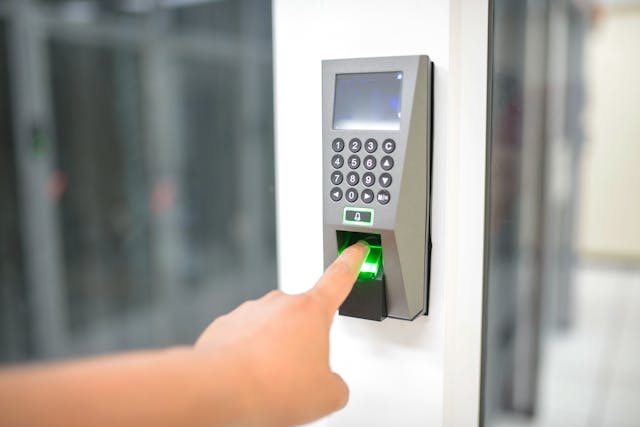How easy is it for an intruder to break through your front door? Here’s how to tell if your front door is secure and some tips on how to keep your home protected.
If an Intruder Can Break in With Minimal Effort
Intruders are more likely to break in if it looks like there’s an easy way in. Is your house surrounded by a lawn, trees and shrubs that reach the front door? This makes an easy hiding spot so burglars can’t be seen breaking in.
An unlit pathway makes it easy for intruders to reach your front door. If you keep your spare keys under the mat, have open windows within reach of the door and a big pet door that opens wide, chances are someone can easily get in.
9 Ways to Deter Potential Intruders
Front-door safety is about securing the door and providing deterrents to discourage intruders from entering. Here are some methods to ensure that intruders don’t make it to the front door at all.
1. Install a Doorbell Camera
Invest in a doorbell camera so you can easily monitor your front porch. With two-way audio, you can shout a warning if unwelcome visitors approach. Doorbell cameras also collect footage, so if someone tries to break in, you have their face on camera and can hand it over to the police. It’s also a good idea to get a camera with night vision so you can see details, even in low light.
2. Get a Smaller Pet Door
Intruders may view a large doggy door as an opportunity to enter the house without breaking anything. Although it’s rare, you want to cover all your bases. Install a smaller door, get a locking system if you need protection for extended periods or pick a different spot on a wall behind vegetation.
3. Lock Your Mail Slot
To protect your house from intruders, you’ve got to be creative and think like them. One of the sneaky ways an intruder can attempt entry is through the mail slot. Install a box or cage to prevent them from inserting a wire and chord to unlock your door from the inside.
4. Get Motion Sensor Lights For Your Yard
The more light there is, the harder it is to cover up ill-intended actions. Look for motion-sensing flood lights that produce 2,000 lumens, enough to scare someone away. You may also want lights with cameras to keep an eye on your house, even if it’s just to check on your pets during the day. A good camera will have radar detection and smart alerts to distinguish between animals, vehicles and packages.
5. Change Your Door
The most durable and secure doors are made from steel or solid-core wood. If anyone tries to kick the door down, you can rest assured it won’t break.
If you choose steel, ensure the door has insulated foam in the core, as they’re more likely to absorb cold and heat due to steel’s conductive properties. Otherwise, steel is notable for its sturdiness and resistance to inclement weather. Plus, a new modern door can significantly increase your home’s curb appeal.
6. Reinforce Your Door
In addition to a sturdy front door, it’s a good idea to reinforce your front door with security braces like a flush deadbolt, barricade bars or door jammers that will make the door unmovable. It may also help to have a security screen. You can get a one-way screen that blocks visual access from the outside but allows people inside to see everything clearly.
7. Install Smart Locks
Take advantage of the high-tech security smart locks available to protect your home. Unless an intruder is an advanced safe-cracker trained in locksports, it’s much harder to guess a code than to pick the lock. Even if you are forgetful, you can always unlock the door with your phone or tablet.
This method also works well if you have temporary tenants. You give them a unique code and when they move out, you change it for improved security.
8. Try Bump Resistant Locks
Prevent intruders from unlocking your door with the bumping technique – inserting a special key or hammer into the lock and forcing the pins in the lock cylinder to open the door. Bump-proof locks remove the pin mechanism, making it harder to use a bumping key.
9. Electronic Pet Door
Give your pet their own copy of the keys with an electronic pet door. No need to worry about stray raccoons when Buddy has a chip or signaling device in his collar to unlock the door only when he approaches.
Newer doors can even detect and prevent access if your pet often brings back critters as gifts. Go for a directional door that only unlocks when your pet walks towards it, so it’s not sliding open whenever they’re near it. Some options allow you to lock and unlock remotely or track your pet’s movement.
Make It More Difficult to Break In
Front doors are still the most common entry points for burglars. Yours can be nearly impenetrable with some security additions and extra attention paid to any potential vulnerabilities.

Daisy is the engine behind Be-Safe.org — from content production to product reviews and more. What drives her is the passion to make home security information easily available.





